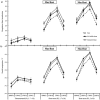Reducing rumen starch fermentation of wheat with three percent sodium hydroxide has the potential to ameliorate the effect of heat stress in grain-fed wethers
- PMID: 29293755
- PMCID: PMC6292325
- DOI: 10.2527/jas2017.1843
Reducing rumen starch fermentation of wheat with three percent sodium hydroxide has the potential to ameliorate the effect of heat stress in grain-fed wethers
Abstract
Selection for high productivity has resulted in ruminants adversely affected by heat stress (HS) due to their high metabolic rate and feed intake. One mechanism to ameliorate HS is to reduce the forage-to-concentrate ratio in the diet, although the inclusion of readily fermentable grains can reduce heat tolerance. The aim of these experiments was to investigate a chemical method for reducing the rate of fermentation of wheat and its effect on improving heat tolerance in sheep. In the first experiment, fermentation kinetics and buffered rumen fluid pH variation during in vitro incubation of corn, wheat, and 3% NaOH-treated wheat grains were compared. This experiment showed that corn and 3% NaOH-treated wheat had a slower (-23 and -22%, respectively; < 0.001) rate of gas production and elevated buffered rumen fluid pH ( < 0.001) compared with wheat. In the second experiment, 31 Merino × Poll Dorset wethers were housed in 2 climate-controlled rooms and were fed either corn grain plus forage (42.7% starch; were fed either corn grain plus forage (CD), wheat grain plus forage (WD) or 3 % NaOH-treated wheat plus forage (TWD) during 3 experimental periods: period 1 (P1), which consisted of 7 d of thermoneutral conditions (18 to 21°C and 40 to 50% relative humidity) and 1.7 times maintenance feed intake; period 2 (P2), which consisted of 7 d of HS (28 to 38°C and 30 to 50% relative humidity) and the same feed intake as in P1; and period 3 (P3), which consisted of 7 d of HS as in P2 and 2 times maintenance feed intake in a randomized control experiment. Water was offered ad libitum. The impact of HS was quantified by increases in rectal temperature, respiration rate (RR), and flank skin temperature (FT); variations in blood acid-base balance; and glucose, NEFA, and heat shock protein 70 (HSP-70) plasma concentrations. All physiological variables were elevated during HS, especially when wethers had greater feed intake (P3). Wethers fed CD had lower RR, rectal temperature, and FT than wethers fed WD ( < 0.001) and wethers fed TWD had lower RR and FT than wethers fed WD during HS ( < 0.05). There were reductions in blood CO, HCO3, and base excess concurrent with increases in blood partial pressure of O and pH during HS ( < 0.05). Heat stress reduced plasma NEFA and glucose concentrations whereas it increased prolactin ( < 0.05). Prolactin and HSP-70 plasma concentrations were greater for WD-fed wethers ( < 0.001) associated with Prolactin and HSP-70 plasma concentrations were greater for WD fed wethers (P < 0.001) during HS. These data indicate that the slow rate of rumen fermentation of CD and TWD can reduce the heat released during feed fermentation in the rumen, improving heat tolerance in sheep.
Figures





Similar articles
-
Effect of feeding slowly fermentable grains on productive variables and amelioration of heat stress in lactating dairy cows in a sub-tropical summer.Trop Anim Health Prod. 2018 Dec;50(8):1763-1769. doi: 10.1007/s11250-018-1616-5. Epub 2018 May 23. Trop Anim Health Prod. 2018. PMID: 29796791
-
Feeding slowly fermentable grains has the potential to ameliorate heat stress in grain-fed wethers.J Anim Sci. 2016 Jul;94(7):2981-91. doi: 10.2527/jas.2016-0295. J Anim Sci. 2016. PMID: 27482685 Clinical Trial.
-
Effects of mild heat stress and grain challenge on acid-base balance and rumen tissue histology in lambs.J Anim Sci. 2006 Feb;84(2):447-55. doi: 10.2527/2006.842447x. J Anim Sci. 2006. PMID: 16424273
-
Grain processing effects on starch utilization by ruminants.J Anim Sci. 1986 Nov;63(5):1649-62. doi: 10.2527/jas1986.6351649x. J Anim Sci. 1986. PMID: 3539906 Review.
-
Limits to starch digestion in the ruminant small intestine.J Anim Sci. 1986 Nov;63(5):1634-48. doi: 10.2527/jas1986.6351634x. J Anim Sci. 1986. PMID: 3539905 Review.
Cited by
-
Nano-chromium picolinate and heat stress enhance insulin sensitivity in cross-bred sheep.Anim Nutr. 2023 Jan 17;13:173-184. doi: 10.1016/j.aninu.2023.01.003. eCollection 2023 Jun. Anim Nutr. 2023. PMID: 37388457 Free PMC article.
-
Reducing the Fermentability of Wheat with a Starch Binding Agent Reduces Some of the Negative Effects of Heat Stress in Sheep.Animals (Basel). 2022 May 28;12(11):1396. doi: 10.3390/ani12111396. Animals (Basel). 2022. PMID: 35681860 Free PMC article.
-
Effects of Heat Stress in Dairy Cows Offered Diets Containing Either Wheat or Corn Grain during Late Lactation.Animals (Basel). 2022 Aug 10;12(16):2031. doi: 10.3390/ani12162031. Animals (Basel). 2022. PMID: 36009623 Free PMC article.
-
Effect of feeding slowly fermentable grains on productive variables and amelioration of heat stress in lactating dairy cows in a sub-tropical summer.Trop Anim Health Prod. 2018 Dec;50(8):1763-1769. doi: 10.1007/s11250-018-1616-5. Epub 2018 May 23. Trop Anim Health Prod. 2018. PMID: 29796791
-
Physical Pretreatments of Cassava Chips Influenced Chemical Composition, Physicochemical Properties, and In Vitro Digestibility in Animal Models.Animals (Basel). 2024 Mar 15;14(6):908. doi: 10.3390/ani14060908. Animals (Basel). 2024. PMID: 38540006 Free PMC article.
References
-
- Alamer M. 2011. The role of prolactin in thermoregulation and water balance during heat stress in domestic ruminants. Asian J. Anim. Vet. Adv. 6:1153–1169. doi:10.3923/ajava.2011.1153.1169 - DOI
-
- Ankom 2016. ANKOM RF gas production system – Operator's manual. https://www.ankom.com/sites/default/files/document-files/RF_Manual_RevF_.... (Accessed 15 May 2017.)
-
- Annison E. F. 1960. Plasma non-esterified fatty acids in sheep. Aust. J. Agric. Res. 11:58–64. doi:10.1071/AR9600058 - DOI
MeSH terms
Substances
LinkOut - more resources
Full Text Sources
Other Literature Sources

